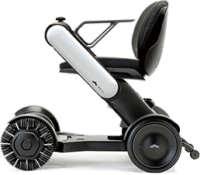Autonomous Wheelchairs
I get around , Yeah, Get around round round I get around, I get around, Get around round round I get around……I’m gettin’ bugged driving up and down this same old strip, I gotta finda new place where the kids are hip…
~Brian Wilson / Mike Love; The Beach Boys
Aging in Place
Exactly when the first wheelchair was invented is anybody’s guess–but the origins of wheeled transportation devices are thought to go back as far as the ancient Greeks and have been depicted on stone carvings from China. It is thought the beginning of a purposefully designed chair with wheels (“invalid’s chair”) was Invented in 1595 for King Phillip II of Spain. The contraption sported small wheels attached to the end of a chair’s legs with a platform for Phillip’s legs and an adjustable backrest. Lucky for the King, he had servants to push him about because it was NOT self-propelled.
The X frame (see image) wheelchair, like most models in current use today, was the creation of Herbert Everest and Harry Jennings. They were engineers and in 1933 designed a chair that could be folded up and put in a car. Nearly 20 years later a Canadian named George Klein and his team designed the first motorized wheelchair to help WWII veterans who returned home with injuries. This basic design has endured with multiple variations, for decades.
Autonomous Wheelchairs
Fast-forward to the introduction of The SMART self-driving wheelchair which was released from development in 2016. Daniela Rus is Director of MIT’s Computer Science and Artificial Intelligence Laboratory and a principal investigator in the SMART Future Urban Mobility research group. She notes:
When we visited several retirement communities, we realized that the quality of life is dependent on mobility. We want to make it really easy for people to move around.”
First designed for airports and hospitals, the autonomous wheelchair, or “urban mobility” device is well on its way to making a wider impact in transporting humans in multiple environments.
Birth of Personal Mobility
The story of WHILL began in 2009 out of a small apartment in Tokyo, Japan. The startup today has grown into a “global company with thousands of customers experiencing a new and exciting way to move, enjoy the activities they love, and explore unhindered.” The company emphasizes mobility (not disability) and employs verbs like; EXPLORE THE WORLD, LIVE. WORK. PLAY. COMPLEMENT YOU, FEEL SAFE AND SECURE.
The WHILL Personal Electric Vehicles are bringing a fresh perspective to personal mobility with an innovative design and state-of-the-art technology–creating the confidence to drive anywhere with unprecedented independence and style.”
~Company website
What was originally designed in the 18th century as a means of transport primarily for the wealthy, the wheelchair as gone through many evolutions, from medical devices to help “handicapped,” to performance sports equipment, and now personal mobility devices moving modern humanity. And the innovation will continue, which is hopeful for an aging population that is accustomed to going most anywhere they want–when they want.
See

Autonomous Wheelchairs Model Ci

